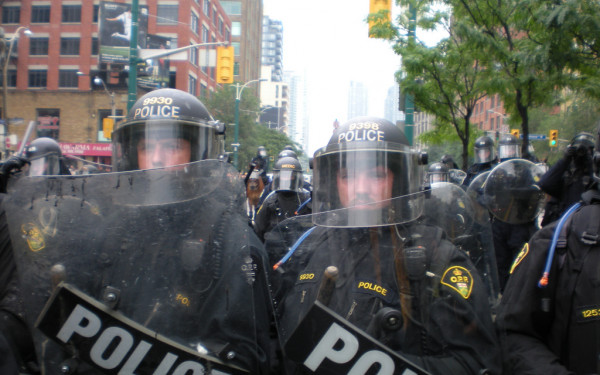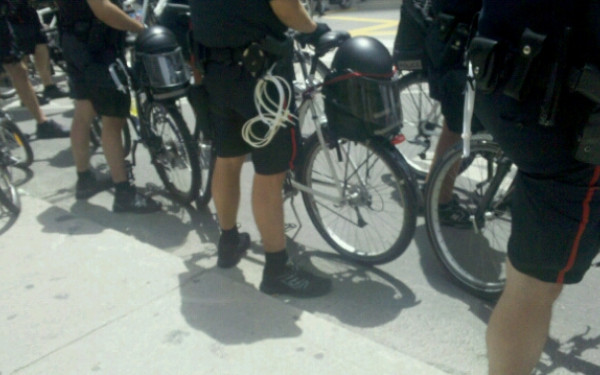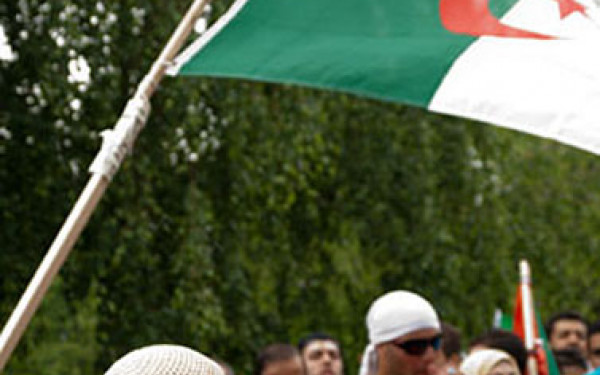A Decade After
A Look Back at the 2002 Netanyahu Riot
On Sept. 9, 2002, for the first time in 30 years, riot police were deployed around the Sir George Williams campus of Concordia University to contain a protest.
Around 1:00 p.m., protesters smashed two windows on the Hall Building’s ground floor. Within minutes, the building filled with pepper spray and tear gas as the riot police dispersed the crowd. The protest, despite what you may think, wasn’t about tuition fees.
Jewish student organization Hillel had invited then-former (and now current) Israeli Prime Minister Benjamin Netanyahu to give a speech, and pro-Palestinian stdents and supporters decided to gather in front of the Hall Building to protest the speech.
Confrontations between both sides escalated, leading to the police intervention and ultimately, the cancellation of the speech. The event, since known as the “Netanyahu riot,” made headlines throughout the world the following days and for several weeks.
Mounting Tensions
The events of Sept. 9 happened in the context of rising tensions between both communities.
At the beginning of the previous academic year, the Concordia Student Union had faced criticism—within the university and at the national level—for its controversial agenda.
The controversy wasn’t due to their political maneuvering, however, but rather the 2001 edition of the free day-planner the union traditionally makes available to students at the start of the fall semester. This particular one was called “Uprising,” and featured a distinctly pro-Palestinian stance.
The 320-page agenda combined a “student survival guide” with opinions pieces on a host of topics ranging from sexual orientation, police brutality and student activism to the Israeli-Palestinian conflict.
“Intifada. Out of our houses and into the streets,” read the agenda introduction. “Take arms for revolution.”
The agenda, which was handed out in the weeks preceding the Sept. 11 attacks, also featured a page with planes crashing into a room filled with businessmen, titled “This is not an agenda called Uprising. It is an agenda for uprising.”
Understandably, the reaction was strong. “Is this a blueprint for Osama bin Laden’s youth program in North America?” B’nai Brith Canada Executive Director Frank Dimant asked at a press conference on Oct. 2.
On Oct. 11, the Concordia Thursday Report noted, “For the second time in a month, The Gazette published an editorial denouncing the CSU as a ‘personal playground for a bunch of radical professional activists.’”
Students started circulating a petition to trigger new elections, gathering 3,000 signatures. Before it was submitted, then-CSU president Sabrina Stea resigned, citing the administration’s interference as her reason for stepping down.
“The administration […] has steadily played a direct and manipulative role in seeking to undermine the student union by downplaying the mandate we had won from the student body,” wrote Stea.
“Concordia’s downsizing of everything from postering space to student newspaper boxes is sending a clear message, as is the sterile design of the new buildings: this is a serious place of learning, not a social laboratory,” wrote former The Link editors Justin Giovannetti and Terrine Friday in 2009.
Concordia’s Response
Despite minimal property damage, as noted in Concordia’s report—the only serious concern at the time was the pepper spray circulating through the ventilation system—the events of Sept. 9 had a lasting impact on Concordia and its image.
During a Board of Governors closed session on Sept. 18, a special policy was adopted stipulating a “cooling-off period at Concordia University.”
The policy put a ban on all Middle East-related activities, and a ban on groups tabling on the first and second floors—for any activities.
After heavy criticism, including Amnesty International sending a letter to Rector Frederick Lowy denouncing the measure as excessive, the ban was only partially lifted two months later, and tabling was still prohibited except for CSU elections.
Then-president Lowy was also granted the power to expel students in “exceptional cases”—a power usually reserved to Academic Hearing Panel and student tribunals.
Mediation between the two student groups did not yield effective results.
“We did what we could to mediate between the groups with the assistance of then-Dean of Students Donald Boisvert,” said Sabine Friesinger, CSU president during the Netanyahu riots and current reporter for Concordia University Television, in an email to The Link.
“It will be easier to communicate with each other when the mediator isn’t so biased,” however, said then-Hillel president Noah Sarna to The Gazette in 2003, when the mediation process was still ongoing.
The university ultimately identified 19 people who participated in the violence on Sept. 9. Out of the 19, 11 were students and were charged by the university. Under Concordia’s policies, the identities of the charged students were not released.
To date, only a few of them have been identified, including Yves Engler, CSU VP Communications in 2002, who was suspended for five years.
Risk Assessment Committee
In the wake of the Netanyahu riot, Concordia established a Risk Assessment Committee. Little was known about it until Concordia student David Bernans’ request to hold a reading for the launch of his book North of 9/11 at Concordia was denied by the committee in 2006.
Bernans filed an Access to Information request to learn more about the denial, which was itself denied. While his appeal at the Commission d’accès à l’information was rejected, documents received by the commission showed the ad hoc committee existed, and Concordia’s VP Services at the time, Michael Di Grappa, was overseeing it.
In 2004, the university decided to not allow former Israeli prime minister Ehud Barak to speak on campus after consultation with the committee.
Its operating model and members remain unknown to this day—the commission rejected Bernans’ appeal partly on the basis that it wasn’t capable of dealing with matters beyond accessing documents.
“There is no Risk Assessment Committee to oversee events on campus,” said Concordia University spokesperson Chris Mota in an email. “That was a short-lived initiative proposed in response to the Netanyahu events and it quickly became clear such a committee was not required.”
Mota recognized, however, that “service and support units do in fact assess operational requirements and potential impacts for events held on campus with a view to ensure effective coordination of activity in support of the success of the events.”
“The Risk Assessment Committee was a bureaucratic and Big Brother-like attempt at clamping down on activism at Concordia, but clearly it was a failure,” said Friesinger.
Student Activism
“Universities became spaces where issues of public relations and image were more important than the pursuit of knowledge and deeper understanding of issues that affect our society and the communities that gravitate around the universities,” said Friesinger.“I think that in any conflict situation, more discussion and more debate is needed. A ban on discussion always serves the status quo and can never lead to a better understanding or to any kind of desirable change,” she continued.
“As the student union president, I always insisted and fought strongly for the rights of students to fair trials. I hope the student union this year will be doing the same when it comes to the students who are in trouble over the strike activities.”
Despite student mobilization at Concordia last spring to protest the tuition fee increase, many feel student activism has not been the same since.
“Concordia’s downsizing of everything from postering space to student newspaper boxes is sending a clear message, as is the sterile design of the new buildings: this is a serious place of learning, not a social laboratory,” wrote former The Link editors Justin Giovannetti and Terrine Friday in 2009.
“Student activism, conflict and churning debate are no longer welcome,” they concluded. “The university re-examines its practices and policies on a regular basis to ensure members of the community can conduct their activities freely and with respect,” said Mota when asked whether such events could reoccur at Concordia today. “That being said, policy can’t prevent behavior.”
—with files from Steve Faguy
To learn more about the 2002 Netanyahu Riot, watch the NFB documentary Discordia, made shortly afterward, at nfb.ca/film/discordia.





